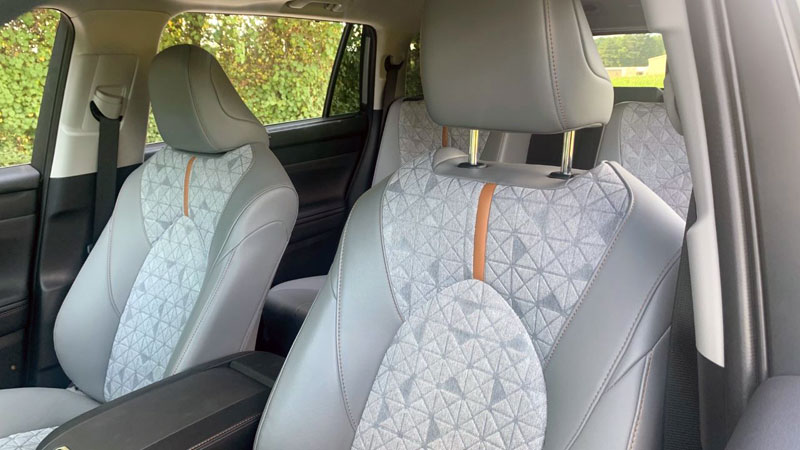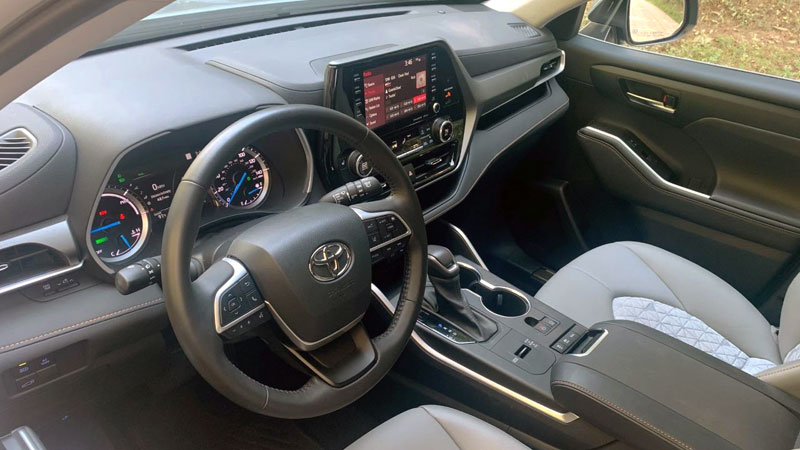The Toyota Highlander is a three-row, midsize crossover utility vehicle with room for seven or eight. It’s the crossover complement to the Toyota Sienna van, with both models ideal for growing families.
The Highlander Hybrid is the fuel efficiency champ in this segment, matching the hybrid-only Sienna with a combined 36 mpg. But unlike the Sienna, buyers can shop for a gasoline-only model, giving them solid options, something few other manufacturer claim.
2022 Toyota Highlander Review
Our test vehicle was the Highlander Hybrid, but it is worth mentioning the gasoline grades that are also available. We’ll touch on both choices where appropriate.
The 2022 Highlander (gas-only) is available in six grades: L ($35,855), LE ($38,055), XSE ($42,650), XLE ($41,055), Limited ($44,010), and Platinum ($48,010). With most trims, all-wheel drive is a $1,600 option. The freight charge is an additional $1,335.
There are also four hybrid grades available: LE Hybrid ($39,555), XLE Hybrid ($42,555), Limited Hybrid ($46,510), and Platinum Hybrid ($51,460). Again, front-wheel drive is standard and all-wheel drive is available.
Exterior Remarks
Lots of curves, body sculpting, and stylish external lighting elements dress the Toyota Highlander. Save for the exterior badging, the hybrid is not easily distinguishable from the gas model. We like that because radical styling is no longer necessary to draw attention to electrified vehicles.
The front fascia is dramatic with its gaping maw, sleek headlights, and deep alcoves. The rear complements that look with its own set of dramatic taillights that draw attention to this model. If the overall look seems busy, that’s a fair assessment. The recessed front pillars, kicked-up beltline, and an assortment of lines and curves showcase this utility vehicle.
Hybrid models come better equipped, thanks to starting with higher trims. LED lighting is standard and includes fog lights. Keyless entry comes standard and roof rails are available. A power-operated liftgate is included.
The hybrid models come with 18-inch painted alloy wheels, although 20-inch wheels are supplied with the two top grades. Heated side mirrors, keyless entry, and a rear spoiler are other features of note.
Among the upgrades is a power tilt-and-slide moonroof with a sunshade. If you desire enhanced interior lighting, Toyota offers a panoramic sunroof with a sunshade that sits behind the moonroof. It supplies a great way to brighten the cabin.
Interior Highlights

Buyers have a choice of seven- or eight-seat placements in the Highlander. The interior is roomy, although the third row is tight. We found the Volkswagen Atlas has the roomiest third-row seat, but no hybrid option is available.
The Kia Telluride and Hyundai Palisade may offer the best interiors in this class, but the Highlander supplies a strong entry, nonetheless. Quality materials, excellent fit and finish, and plenty of amenities make this model enticing.

Cloth seats, three-zone climate control, and an 8-way power driver’s seat come standard. Move up through the grade range and a leather-wrapped steering wheel, leather-trimmed seats, second-row sunshades, and ambient interior lighting are incorporated.
Other features available include heated front seats, ventilated front seats, heated second-row seats, and a heated steering wheel.
Technology Features
There is much to be desired about the Highlander’s technology offerings. An 8-inch touchscreen display comes standard as does a 6-speaker audio system. Apple CarPlay and Android Auto smartphone compatibility, Bluetooth, a Wi-Fi hotspot, and satellite radio are included. Five USB ports are found inside.
Move up the grade range and such features as a 12.3-inch touch-screen display comes in. One matter worth mentioning: the Entune infotainment system is much improved, although not yet on the level of systems from Dodge and Chevrolet.
Navigation, an 11-speaker JBL audio system, and wireless device charging can also be had.
Safety Features
Beyond the required rearview camera and suite of airbags, every Highlander model comes well equipped. The features list is impressive and begins with automatic high-beam headlights, traffic sign recognition, and a rear-seat minder.
Toyota also supplies forward collision warning, forward automatic emergency braking, and pedestrian detection. Adaptive cruise control and lane departure alert and lane control are included.
There are a few options available, including blind-spot monitoring with rear cross-traffic alert. A rearview camera mirror, adaptive headlights, front and rear parking sensors, and a head-up display are available.
Powertrain Choices
Although our test model was the Highlander Hybrid, we’ve also driven the standard Highlander. The 3.5-liter V6 in the gas model puts down 295 horsepower and 263 pound-feet of torque and works with an 8-speed automatic transmission.
Notably, when properly equipped it pulls up to 5,000 pounds. It would be our choice for anyone needing to maximize payload or to pull a boat or trailer.
The Highlander Hybrid comes with a 2.5-liter four-cylinder engine. That engine alone wouldn’t be powerful enough, but with one (FWD) or two (AWD) electric motors at work, there is more power available.
Indeed, the engine alone develops 186 horsepower and 175 pound-feet of torque. But when the engine combines with the electric motor, there is 243 horsepower on tap.
Otherwise, there are times when electric propulsion dominates for enhanced efficiency. This powertrain works with an electronic continuously variable transmission to shuttle power to the wheels.
Driving Highlights
Gas or hybrid? In this segment, the Toyota Highlander gives you a choice. The competition, however, is heating up with hybrid variants of the Ford Explorer, Hyundai Santa Fe, and Kia Sorento to consider. But we place the Toyota above the rest, notably for the company’s quarter-century hybrid building experience and durability.
Neither Highlander model though offers an exhilarating driving experience. The steering is light, although it handles with precision. That lightness, though, is perhaps too predictable for some drivers. Even so, we found the Highlander delivers firm braking and a comfortable ride.
The gas model works as expected, as it delivers strong step-off acceleration and competent passing power. The V6 is strong, able to handle the added weight of people and equipment, and can pull a small boat or camper with ease. That power, though, comes at the expense of fuel efficiency as the gas Highlander delivers no better than 24 mpg combined or one-third less than the hybrid.
The Highlander Hybrid offers pleasant surprises, including electric-only power at low speeds and when cruise control is set, including at highway speeds. The gas engine, however, kicks in the moment sensors detect more power is needed, but if you’re light with your foot you can reduce the times when gas is required.
The Highlander Hybrid also possesses a tow rating of 3,500 pounds. Keep in mind, though, that your efficiency drops with the greater load, although the same can be said for the gas-powered model.
Toyota Highlander Considerations
Gas or electrified? The choice may not be so clear for some, but the price difference is just $1,500. This means the hybrid investment should pay off in two years with significant fuel savings reached in subsequent years.
Keep in mind, though, that the hybrid system is warranted for 8 years or 100,000 miles (longer in California). If the system eventually fails post warranty, the cost will rival or exceed an engine or transmission replacement. Fortunately, Toyota hybrid systems are proven.
Keep the Sienna in mind if you like the convenience of sliding rear doors. That’s the main difference between these two very similar models.
Photos copyright Auto Trends Magazine. All rights reserved.
- 2024 Mazda CX-50: A Compact SUV with Premium Aspirations - Apr 15, 2024
- 2024 Ford Mustang (Iconic Pony Car Evolves) - Apr 4, 2024
- 2024 Ford Maverick (Looks Like a Truck, Drives Like a Car) - Mar 28, 2024




